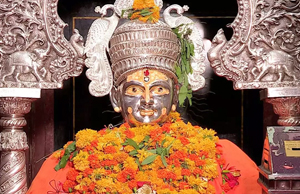Trimbakeshwar – one of the holy places of not only Maharashtra but the whole India is near Nashik. Trimbakeshwar is one of the twelve Jyotirlingas in India. The following verse shall explain the importance of this sacred place and the next one gives names of the Twelve Jyotirlingas in India.
The following sanskrit sloka describes about the 12 Jyotirlingas
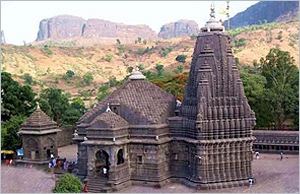 सौराष्ट्रे सोमनाथं च श्रीशैले मल्लिकार्जुनम्। उज्जयिन्यां महाकालमोङ्कारममलेश्वरम्॥
सौराष्ट्रे सोमनाथं च श्रीशैले मल्लिकार्जुनम्। उज्जयिन्यां महाकालमोङ्कारममलेश्वरम्॥
परल्यां वैद्यनाथं च डाकिन्यां भीमशङ्करम्। सेतुबन्धे तु रामेशं नागेशं दारुकावने॥
वाराणस्यां तु विश्वेशं त्र्यम्बकं गौतमीतटे। हिमालये तु केदारं घुश्मेशं च शिवालये॥
एतानि ज्योतिर्लिङ्गानि सायं प्रातः पठेन्नरः। सप्तजन्मकृतं पापं स्मरणेन विनश्यति॥
एतेशां दर्शनादेव पातकं नैव तिष्ठति। कर्मक्षयो भवेत्तस्य यस्य तुष्टो महेश्वराः॥:
द्वादश ज्योतिर्लिंग स्तोत्रम्
This says that anybody who visits Trimbakeshwar attains salvation. There is no sacred place like Trimbakeshwar, no river like Godavari, no mountain like Brahmagiri etc. The reasons for its being so sacred are – Godavari river originates in this place, its a place of Tri-Sandhya Gayatri, the birth place of Lord Ganesha, a place of the first Nath of Nath Sampradaya consisting of Gorakhnath and others, a place where Nivrittinath was made to imbibe the holy knowledge by his Guru Gahininath, a place where Nivrittinath made his brothers and sister attain the self by his preaching. This is the holiest place to perform Shraddha ceremony. Nirnaya Sindhu – a religious book of Hindus, mentions that this place, where Sahyadri mountain and Godavari river exist is very purifying on the whole earth and is therefore very important for performing Shraddha ceremony.
a) Shri Trimbakeshwar Jyotirling and
b) Kushavarta – the place from where river Godavari takes its course. A dip in this sacred river wipes off the sins, is the belief of people. The sage Gautam committed a sin of murdering a cow and by taking bath in this river, wiped off his sin.

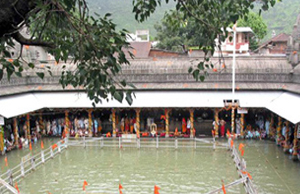
About 38 kms away from Nashik Road Railway Station, it is connected by bus and taxi service. There are modern Dharmashalas (caravansary) built by charitable Gujarathi Community available for stay for three days to any individual. The stay can be extended by written permission of the trustees. Besides, there are big houses of Kshetropadhyes (the local priests), where lodging and boarding is made available. ![]()
| By Air | Nearest airport is Nashik 39 kms. |
| By Rail | Nearest railhead is Nashik Road 44 kms on Central Railway. |
| By Road | Bombay – Trimbakeshwar 180 kms. Nashik – Trimbakeshwar 28 kms. State Transport buses ply between Nashik – Trimbakeshwar frequently. |
| Reservation | Bombay and Trimbakeshwar. |
| Checkout Time | 12.00 noon. |
| Accommodation | Self contained rooms [11 blocks], dormitories [2 blocks – 20 beds] and tents. |
At the time of the marriage of Lord Shiva with Parvati, all the Devarshis gathered together. Brahmadev, the creator of the Universe, seeing the beauty of Parvati, had a discharge of semen. Lord Shiva observing this, offered him water of Ganges, the purest water and said, “You will wipe off your sin by this water”. Brahmadev kept the holy water in his kamandalu (a particular container made out of dried fruit carried by Sadhus) and was purified by its bath.
Brahmadev worshipped God Trivikram when he came to Satya Loka (on earth) with the same holy water of the Ganges, to get the river Ganges held up by God Shankar on his head, to flow. River Ganges in the form of a woman was enjoying with God Shankar, which was noticed by Lord Shiva’s wife Parvati. She planned to drive Ganges away from her husband. Parvati and her shri ganeshson Ganesh came to live in Gautama’s Ashrama with Parvati’s friend Jaya. There was a famine of 24 years and people were affected by the pangs of hunger. However, Varun – the God of Rains, pleased with Sage Gautama arranged rains every day in Gautam’s Ashrama (dwelling place) which was in Trimbakeshwar. Gautama used to sow rice in the surrounding fields of his Ashrama in the morning, reap the crop in the afternoon and with it fed a large group of rishis, who took shelter in his Ashrama on account of the famine. The blessings of the group of rishis increased the merit (Punya) of Gautam. Lord Indra’s position became shaky because of his increased merit. So Indra ordered clouds to rain all over Trimbakeshwar, so that the famine will be over and Rishis will go back and the increasing merits of Gautam will be weakened. Although the famine was over, Gautam urged the Rishis to stay back and kept on feeding them and gaining merit. Once he saw a cow grazing in the paddy field and he drove her away by throwing Darbha (sharp, pointed grass). The slender cow died by this. It was Jaya – Parvati’s friend, who had taken the form of a cow. This news upset the Rishis and they refused to luncheon at his Ashram.
Gautam requested Rishis to show a way out of this sin. He was advised to approach Lord Shiva and request him to release Ganges and a bath in the Ganges would set him free of his sins. Gautam then practiced penance by going to the peak of Brahmagiri. Lord Shankara was pleased by his worships and gave him the Ganges. However, Ganges was not prepared to part with Lord Shiva, which irritated him. He made Tandav Nrutya (dance) on the peak of Brahmagiri and dashed his jata there. Frightened by this action, Ganges appeared on Brahmagiri. Later on Ganges appeared in the Trimbak Tirtha. Gautam praised her but she off and on appeared on the mountain at various places and disappeared in anger. Gautama could not bathe in her waters. Ganges then appeared in Gangadwar, Varaha-tirtha, Rama-Laxman tirtha, Ganga Sagar tirtha. Still Gautama could not bathe in her waters. The Gautama surrounded the river with enchanted grass and put a vow to her. The flow stopped there and the tirtha thus came to be called Kushavarta. It is from this Kushavarta that the river Godavari flows up to the sea. The sin of killing a cow by Gautama was wiped off here.
Sinhastha Mahatmya speaks of Lord Rama having made the Yatra at Trimbakeshwar. A shraddha on the river Godavari gives great satisfaction to the forefathers. If it is not done in this place, it is considered as a religious sin. So Ganga Pujan, Ganga Bhet, Deh Shuddhi Prayaschitta. Tarpan Shradha, Vayan, Dasha Dana, Gopradan etc. Rituals are done in Trimbakeshwar. Mundana and Tirtha Shraddha are also performed here.
Kushavarta is called as Teertharaj, since it has six corners. After finishing the tirtha-yatra at Kushavarta, a pilgrim should proceed by the northern bank of Godavari and visit Nilsangameshwar, Vivah Vinayak, Satya Narayan, Dhaneshwar Mahadev, Tarangeshwar, Setupaleshwar etc.
The Lord Shiva at Trimbakeshwar is worshipped by recitations of Rudra, Rudri, Laghu Rudra, Maha Rudra or Ati Rudra puja. Actually Rudrashak is a religious fruit which is said to be found in lord Shiva’s neck in the form of Rudra garland. Some of the trees of Rudrashak is also found in Trimbakeshwar. For more details read Rudraksha Mahima
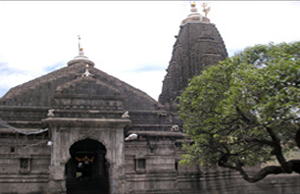 Kushavarta was a large area. Shreemant Rao Sahib Parnekar has built up the banks with stone pavement and with verandahs on all sides. Near Kushavarta is Kanchan and Kankhala tirtha where , the it is said , that dead human bones disappear. The flow of Godavari runs from this place. There are temples at the four corners of Kushavarta. On the south east conrner is the temple of Kedareshwar Mahadev, who in disguise of Kedarbhatta made Gautam to bathe in the waters and gave him prayaschitta (repentance) for the sin of killing a cow. To the south-west is Sakshi Vinayak , who is a witness to the yatra -vidhi of all pilgrims. To the north-west is Kusheshwar Mahadev and to the north-east is the temple of Godavari. It is said in Trimbak Mahatmya that Godavari was pleased with Gautam and gave him her “Darshana” – appearance in person . At this place the Godavari temple is built.
Kushavarta was a large area. Shreemant Rao Sahib Parnekar has built up the banks with stone pavement and with verandahs on all sides. Near Kushavarta is Kanchan and Kankhala tirtha where , the it is said , that dead human bones disappear. The flow of Godavari runs from this place. There are temples at the four corners of Kushavarta. On the south east conrner is the temple of Kedareshwar Mahadev, who in disguise of Kedarbhatta made Gautam to bathe in the waters and gave him prayaschitta (repentance) for the sin of killing a cow. To the south-west is Sakshi Vinayak , who is a witness to the yatra -vidhi of all pilgrims. To the north-west is Kusheshwar Mahadev and to the north-east is the temple of Godavari. It is said in Trimbak Mahatmya that Godavari was pleased with Gautam and gave him her “Darshana” – appearance in person . At this place the Godavari temple is built.
To the rear of the temple Gangamandir, Shrimant Peshawa has built a big caravansary where Rama and Karpureshwar Mahadev are enthroned. There is a separate temple of Ashwini Kumar in front of Gangamandir. There is a big Ashwattha Narayan tree in front of Kushavarta tirtha. In addition, there are temples of Jwareshwar Mahadev and Kanchaneshwar and statues of Dash Avatar and of thirty-three kinds of deities. The old holy books say that by the order of Lord Shiv, all deities stay here in person, during the period of Sinhastha Parva, to wipe off their sins and to get themselves purified.
The work of constructing the present temple of Trimbakeshwar was begun by Shrimant Balaji Bajirao alias Nanasahib Peshawe in 1755 in the first half of the Margashirsha month (around December) and was completed in 1786. It took 31 years to construct the temple and the cost of 16 lacs then. There are three “Linga” of the size of a thumb and they are called as Brahma, Vishnu and Mahesh – the creator, the organizer and the destroyer. These lingas are natural ( emerged naturally )Water of Ganges flows over the Linga of Shiva. The grant of Rs.1000.00 per month was given for performing puja and offerings etc. The deity is worshipped here thrice a day and an additional worship with flowers at pradosha time.
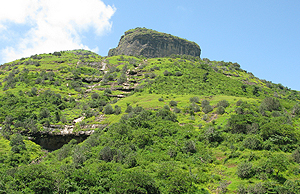 Original Ganges and Trimbak Tirtha are on Brahmagiri mountain adjacent to Trimbakeshwar temple. Brahmagiri is considered as a huge form of Lord Shiva and hence the mountain climbing was considered as a sin. However in 1908 Seth Lalchand Jashodanand Bhambhani of Karachi and Seth Ganeshdas built 500 steps of stone at a cost of Rs. 40,000 then. This has facilitated easy access to Brahmagiri. Godavari is flowing in three directions on the mountain. The one flowing towards east is called Godavari, one flowing towards the south is called Vaitarna and the one flowing towards the west is called the west-flowing Ganga and meets Godavari near Chakra Tirth. River Ahilya meets Godavari in front of the Trimbakeshwar temple. Childless families worship at the Ahilya sangam and it is believed that they do get a child.
Original Ganges and Trimbak Tirtha are on Brahmagiri mountain adjacent to Trimbakeshwar temple. Brahmagiri is considered as a huge form of Lord Shiva and hence the mountain climbing was considered as a sin. However in 1908 Seth Lalchand Jashodanand Bhambhani of Karachi and Seth Ganeshdas built 500 steps of stone at a cost of Rs. 40,000 then. This has facilitated easy access to Brahmagiri. Godavari is flowing in three directions on the mountain. The one flowing towards east is called Godavari, one flowing towards the south is called Vaitarna and the one flowing towards the west is called the west-flowing Ganga and meets Godavari near Chakra Tirth. River Ahilya meets Godavari in front of the Trimbakeshwar temple. Childless families worship at the Ahilya sangam and it is believed that they do get a child.
The first peak of Sahyadri is called Brahmadri. The story associated with this is that Shankar was pleased with Brahmadev and said “I shall be known by your name”. Hence it is called as Brahmagiri. The mountain is 1800 feet high . Its height from sea level is 4248 feet. Five peaks of this mountain are called Sadyo-Jata, Vamdev, Aghora, Ishana and Tat-Purusha and are considered as five mouths of the Lord Shiva and they are worshipped.
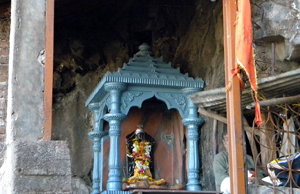 Gangadwar is half way to Brahmagiri mountain. There is a temple of Ganga, now known as Godavari River. Ganga appears first time here, after it vanishes from Brahmagiri Mountain. Godavari comes to Gangadwar from Brahmadri. There are 750 steps to Gangadwar. These were built by Karamsi Ranamull of Village Maska. The work was commenced on 1st of Chaitra in Samwat 1907 and was completed on 5th of Chaitra Samwat 1918 by Seth Hansraj Karamsi. Gangadwar is one of the five tirthas. There is an idol of Ganga and near her feet is a stone of the shape of cow’s head through which Ganga water is flowing drop by drop.
Gangadwar is half way to Brahmagiri mountain. There is a temple of Ganga, now known as Godavari River. Ganga appears first time here, after it vanishes from Brahmagiri Mountain. Godavari comes to Gangadwar from Brahmadri. There are 750 steps to Gangadwar. These were built by Karamsi Ranamull of Village Maska. The work was commenced on 1st of Chaitra in Samwat 1907 and was completed on 5th of Chaitra Samwat 1918 by Seth Hansraj Karamsi. Gangadwar is one of the five tirthas. There is an idol of Ganga and near her feet is a stone of the shape of cow’s head through which Ganga water is flowing drop by drop.
Nearby is Kolambika Devi, Varah tirtha further on is the cave of Gautam for practicing penance where there are 108 Shivalingas. A little further on is Gorakh Gumpha, a place where Gorakhnath practiced penance, the idol is worth seeing. After descending a few steps, Ganga flows from the roots of Audumbar tree. This is known as Rama-Laxman tirtha. Here Rama stopped for a few days and did Shraddha ceremony in memory of Dasharatha. There is Rama temple and Gopalrao Ghanekar built it at a cost of Rs. 25000.00 in 1857. Ganga Sagar is a big tank in the flow of river and is 300 x 400 ft. Shrimant Rajebahadar built it about the year 1678. The Ganga Sagar water is distributed in the village nearby.
Bilwa Tirtha is to the north of Nila mountain. It is one of the five tirthas. There is a temple of Bilvakeshwar Mahadev built by Naro Vinayak Gogte in 1738 at a cost of Rs. 25,000.00
Gautam Tirtha is to the south of the Ganges and the Trimbakeshwar temple. Varun being pleased with Gautam gave this tirtha as a permanent source of water. To the north is Gautameshwar and to the south is Rameshwar Mahadev. This tank is 600 x 400 ft and is built by Shrimant Pandit Zashivale at a cost of Rs. 50,000.00
Indra Tirtha is to the east and near Kushavarta. This is known as Shakra-Kupa for Indra wiped off his curse given by sage Gautam for enjoying Ahilya, by a bath in this tirtha. This is built with cut stone in octagonal form by Vishnu Mahadeo Gadre at a cost of Rs. 22000 in 1778. On the bank of the tirtha is a beautiful temple of Indreshwar Mahadev with an idol of Indra seated on an Airavata elephant.
Besides this there are Vishwanath tirtha, Nilambar tirtha or Moti-tank, Mukund tirtha, Prayag tirtha and Veni-Madhav and other Mahadev temples on the bank of Prayag tirtha. Here is a matha of Nirvana Sampradaya (sect) Nilganga tirtha and nilsangameshwar Mahadev temple are on the north bank of Godavati.
To force Gautam to give up his penance, a friend of Ganga named Jatila took the form of Ahilya, Gautam’s wife. Gautam could make it out and cursed her to be transformed into a river. Then she begged his pardon. Gautam granted her pardon and said that she will be freed of her curse on her joining with Godavari river. This is the Ahilya-Sangam tirtha where Ganga and Godavari join. There is a temple of Sangmeshwar Mahadev.
Two yatras (pilgrimage) are performed here.
A) Ashta tirtha yatra including Ballal tirtha, the sacred place of Gunesh Ganapati, Varansi tirtha, Manakarnika tirtha, Ganga sagar, Rama-Laxman tirtha, Shali tirtha, Kanchan tirtha and Ahilya-Sangam tirtha.
B) Pancha tirtha yatra includes Gangadwar, Kushavarta, Bilwaka, Nilparavata and Kanakhala tirtha. It is believed that one who takes a bath in the above is never reborn.
To Nil mountain, Shreemant Seth Kapol has built about 200 steps. On the summit is the temple of Nilamba Matamba Devi, further on is an ancient temple of Nilkantheshwar Mahadev and an idol of Parashuram. There is an old akhada or matha of the Gosavi sect and an ancient temple of Sadguru Dattatreya.
There are two pradakshinas (ring routes) in this kshetra – one round the Brahmagiri and the other one round Hariharagiri. Pilgrim has to go for pradakshina with holy garment early in the morning visiting and bathing in various tirthas. The tour is to be completed in either a day, three days or five days.
The public and religious institutions in the town are Veda shala, Sanskrit Pathashala, Kirtan Sanstha, Pravachan Sanstha, two gymnasiums, Lokmanya Free Reading Room, municipal office, post and telegraph office, dispensary and a police sub-inspector’s office. Sanskrit Pathashala has produced a good many disciples who have become Shastris and Pandits.
Nivritinath Temple – The elder brother and Guru of Dnyaneshwara took Samadhi here. In his memory a temple is built. Devotees come to visit this temple. There is a three days festival in this temple in the month of Pausha – sometime in January.
